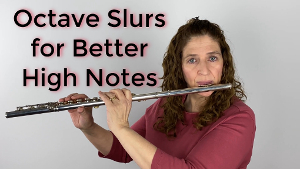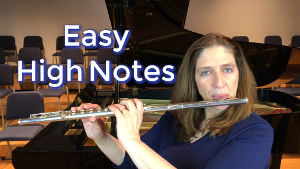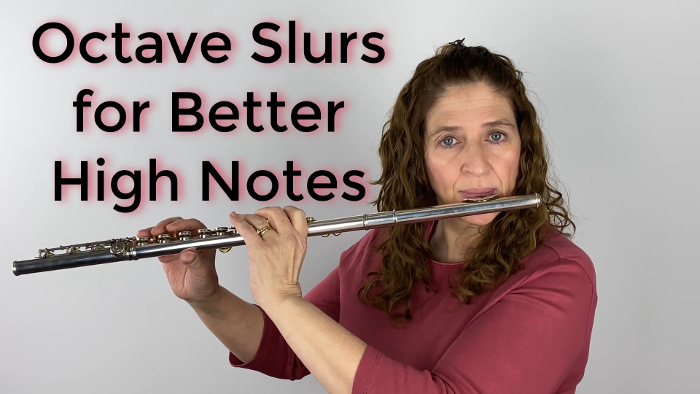A great tone in the high register is often elusive. The high tessitura often creates an embouchure that is tight and small. You can use octave slurs as a technique to conquer this range.
Learning how to play in the higher registers without getting tight and small is a matter of training the embouchure. The embouchure needs to learn to stay loose and open – not small and tight. Once you have learned how to do octave slurs correctly then you will be able to apply this to all high register playing and be able to get the sound that you will love.
Now, what do I mean by an octave slur? Exactly that: begin with a low note and slur up the octave. At this stage of the game, it is best for you begin with a 1st octave note and slur up to the 2nd octave. Once you understand the principle behind what to do you can transfer that information to slurring up to the 3rd octave from the 2nd.
What are the usual problems with high notes? The first problem is getting the octave because you are blowing too much air. Check yourself and see of that is you. It is so easy to blow more air for the upper octave. The second problem is tightening your embouchure and closing it to a very small opening. Now this type of player is still blowing harder for the high notes. But because they have a small opening they can control the air. What is the problem with doing that if the sound is still clear? The tone will always be small with no range of dynamics. It is impossible to play a true forte when there is such a small space for the tone to come out. But there are solutions to this. It can be conquered with careful study. When you work on these octave slurs, you learn to open up your high register and play with a beautiful sound that is not overblown.
When you begin to work on octave slurs it is important to remember to slur rather than to articulate the notes. Sometimes when we play up the octave, or really high or really fast and we’re not comfortable with playing that octave, we tongue the notes on the high register because it’s easier to get your high register out when you tongue it. When you put that little punch of fast air and articulation all together, it’s easier for that high note to come out, and it’s harder to do it when you slur. But if you work with slurring you force yourself to get it correctly.
To begin with I want to have the absolute best low note I possibly can, such as a fantastic F. A nice, rich and full sound with my jaw lowered and my airstream down because that’s how I need my airstream when I’m in the low register. The teeth are apart, and the embouchure is nice and big.
When you have a great low F, you are ready to slur up the octave. Your embouchure goes from ah to ooh. If you notice, to go from ah to ooh, the jaw has to move out not necessarily up.
Now practice just that, move your jaw from ah to ooh. Don’t even try to get the note to come out because it is so often very difficult to feel like you can move your jaw the first time when you’re playing, so you need to sort of go extreme; go all the way so no sound comes out except air.
After you have gone extreme, then try to move half that amount and just see what happens. Sometimes that is all that needs to be said, because the octave happens. If you have tried this and nothing but air comes out, you are still doing it perfectly. You need to experience what the jaw has to do before you can really make the octave sound.
The first step is going all the way. The second step is moving the jaw halfway and see what happens. If it pops up the octave that is fantastic. For most of the students, air is still the only thing that comes out. Do not give up. Keep going.
Now, let’s talk about another aspect of these octave slurs. When you go from ah to ooh, your embouchure tends to close up. The teeth get closer together and that brings the lips closer together. This then does not allow that sound to come out. When I go ah to ooh, I want to stay open and keep open but still with an “oo” embouchure. Why the “oo”? Because the embouchure raises the air stream. Consciously move the air stream to a straight-out flow.
If you are struggling, you can play a G and hold your flute with just your left hand. Then while playing move the right hand down in front of the lip plate and feel where you air is blowing. If it is still down, then you need to move it up. If you feel it move up great!
Remember when using the jaw to move the air stream you do not need to use more air. Listen to yourself and make sure that you are not pushing more air through your instrument.
A third step in the octave slur journey that often helps people get their high note is to raise the upper lip. Yes, raise your upper lip to get the upper octave. Warning, this is an easy thing to overthink. We cannot easily move the upper lip separately. However, you can move it a little bit, and that little bit is just enough. Try it. It works.
Try these octave slurs beginning with F, G, A and B. If you feel like your B sinks and you keep getting the lower octave a low note, that means you must move a little bit more. Remember to keep supporting your notes with your air. If I do not have support, especially as I move to B and higher, then it is probably not going to work, either. You must have support to gain the upper octaves.
If I control it because my airstream moves, then I get the tone I am looking for. My tone is going to be phenomenal in that upper register because I am using my support to get it, not squeezing, and not overblowing, so that it just jumps out at you.
That is using octave slurs to improve your tone. It is going to help you in many ways. It is a little bit tricky to work on, and sometimes people find it a little bit tedious. But it’s pays off. Do the work, pay the piper, and you will be happy that you did.
Have fun!
DoctorFlute
Octave Slurs for Better High Notes on the Flute – FluteTips 125


Getting Spin on Your Third Octave Notes – FluteTips 171

Perfecting Your Third Octave Flute Tips 105

Failure to Plan for Your 3rd 8va Notes is a Plan to Fail – FluteTips 181



